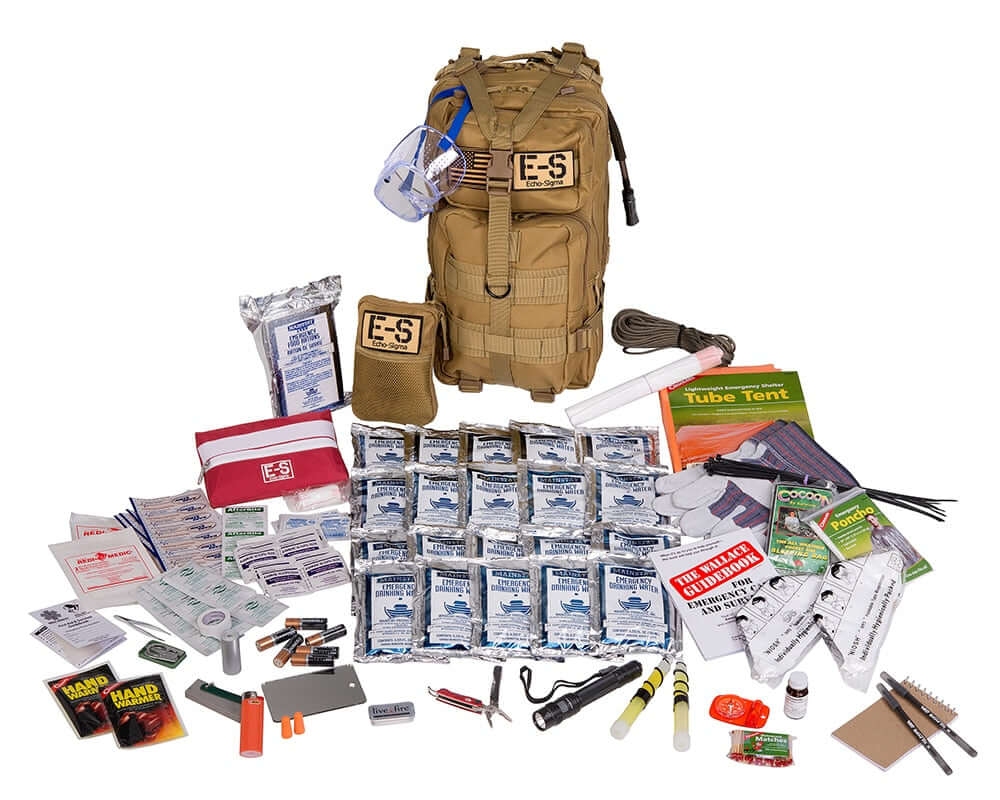When uncertain situations arise, having a well-prepared go-bag can be the difference between comfort and chaos. Whether you're bracing for weather emergencies, preparing for travel, or simply ensuring readiness for the unexpected, a thoughtfully packed go-bag is a crucial tool in your personal safety arsenal. By understanding which essentials to pack, you can secure peace of mind for any scenario, knowing you're equipped with the tools and supplies to handle adversity head-on.
To assemble the perfect go-bag, identify the core items necessary for survival and safety across a variety of situations. Inclusion of personal items should be guided by individual needs and circumstances, while also accounting for tools and protective gear that adapt to changing conditions and environments. Regular maintenance and updating of your go-bag contents ensure that you're ready to go at a moment's notice. Engaging in preparedness training can further enhance your ability to utilize the bag's contents effectively, thus maximizing your resilience in any event.
Key Takeaways
- A well-stocked go-bag ensures preparedness for a diverse range of emergency situations.
- Essentials include survival items, personal necessities, and versatile tools for safety and protection.
- Regular review and practice with your go-bag contents underpin effective emergency response.
Basics of a Go-Bag
Preparing for uncertainties requires you to have a go-bag ready. It’s your quick-grab repository for essentials in any situation, whether it’s an emergency or a spontaneous adventure.
Definition and Purpose
A go-bag is a pre-packed, portable kit that contains critical items you would need to survive for the next 72 hours during an unplanned event. The purpose of a go-bag is to provide you with the necessities that will support your basic needs, such as safety, warmth, food, water, and communication, whenever you might have to leave your home with little notice.
Choosing the Right Bag
Selecting the right bag is the first step in preparing your go-bag. It should be:
- Durable: Constructed from sturdy materials capable of withstanding rough handling and various weather conditions.
- Comfortable: Featuring adjustable, padded straps that ease the load on your shoulders and back.
- Spacious: Enough compartments and space to hold all your essentials without being overly bulky.
- Accessible: Designed with ease of access in mind, so you can quickly find what you need.
Your go-bag should reflect your personal needs while also being lightweight and easy to carry.
Survival Essentials
In any emergency, your survival depends on staying hydrated, nourished, adequately sheltered, and prepared to handle injuries. The following essentials are non-negotiable for your go-bag.
Water and Hydration
- Water Bottles: At least two durable water bottles or a hydration bladder with a minimum capacity of two liters.
- Water Purification: Water purification tablets or a portable water filter to ensure access to clean drinking water.
Food Supplies
- High-energy Food: Pack non-perishable items like energy bars, nuts, and dried fruits.
- Cooking Equipment: A compact stove and a metal pot can be vital for heating food and water.
Shelter and Warmth
- Emergency Blanket: Pack a space blanket to retain body heat.
- Portable Shelter: Include a lightweight tent or a bivy sack for protection against the elements.
First Aid Kit
- Basic Supplies: Sterile gauze, adhesive bandages, antiseptic wipes, and medical tape.
- Tools: Tweezers, scissors, and a multi-tool can handle various medical tasks.
Personal Items
Your go-bag should include personal items crucial for your identity, hygiene, and comfort.
Clothing
- Socks and Underwear: Pack at least two pairs of each for hygiene purposes.
- Layers of Clothing: One lightweight long-sleeved shirt, a pair of pants, and a jacket suitable for the climate are essential to adapt to changing weather conditions.
Personal Hygiene
- Toiletries: Include a toothbrush, toothpaste, and travel-sized shampoo and soap.
- Sanitizing Items: Keep hand sanitizer and wet wipes for situations where water access is limited.
Important Documents
- Identification: Photocopy of your passport, driver's license, and/or ID card.
- Medical Information: List of allergies, medications, blood type, and doctor's contact information.
Tools and Equipment
In your go-bag, certain tools and equipment are indispensable for handling unexpected scenarios efficiently. These items are curated to ensure you're prepared for a range of situations, from minor repairs to emergency signaling.
Multipurpose Tools
- Swiss Army Knife: Equipped with blades, a screwdriver, and can openers, this tool can serve numerous functions in a compact form.
- Pliers: Choose a sturdy pair that can grip, bend, or cut depending on your needs.
Lighting
- Flashlight: Opt for an LED flashlight for long-lasting light; a headlamp frees up your hands for tasks.
- Glow Sticks: Useful as markers or emergency light sources—they're waterproof and don't need batteries.
Communication Devices
- Hand-Crank Radio: A multipurpose device that provides weather updates and can be used to charge your phone.
- Satellite Phone: Critical for staying in touch when cellular networks are down, especially in remote areas.
Navigation Gear
- Compass: A fundamental tool for orienting yourself in unfamiliar terrain.
- Maps: Physical maps are reliable backups when electronic devices fail. Keep local and regional maps in your bag.
Protection and Safety
When preparing your go-bag, it's crucial to consider items that will ensure your safety and enable you to defend yourself in emergencies. These items must be reliable, easy to use, and compliant with legal guidelines.
Self-Defense Items
- Pepper Spray: Compact and effective, pepper spray can incapacitate an attacker, giving you time to escape. Ensure it’s legal in your area before packing.
- Tactical Pen: A durable pen that doubles as a self-defense tool without drawing much attention.
Signaling Devices
- Whistle: A loud whistle can signal for help even when you're out of sight. It’s lightweight and should be attached to the exterior of your bag for quick access.
- Battery-powered Flashlight: Besides lighting your way, it can be used to signal for help through intermittent flashes. Choose one with a long battery life or a hand-crank option.
Special Considerations
When preparing your go-bag, it is vital to include items that address the unique needs of every member of your family, including children and pets, as well as any specific medical requirements.
Children’s Needs
- Food: Pack non-perishable, child-friendly food such as granola bars and applesauce pouches.
- Entertainment: Include books, games, or coloring supplies to keep children occupied.
Pet Supplies
- Food and Water: Have a three-day supply of pet food and water, as well as collapsible bowls.
- Medications/Vaccination Records: Keep an updated record of vaccinations and a supply of any medications.
Medical Conditions
- Prescriptions: Store a week's supply of any prescription medications in a waterproof container.
- Medical Equipment: If you use equipment such as an inhaler or glucose monitor, include spare supplies.
Maintenance and Updating
To ensure your go-bag is always ready for use, pay close attention to regular maintenance and timely updates of the contents.
Regular Checks
Monthly Inspection: You should thoroughly check your go-bag's condition and contents monthly. Confirm the functionality of all equipment, such as flashlights and radios, by testing them. Additionally, review expiration dates on all perishable items such as food, water, and medication, replacing anything that is close to expiring.
Inventory Management: Make a checklist of items in your go-bag and tick them off during your monthly checks. This ensures nothing is missing or damaged. If an item is used, be sure to replace it immediately.
Seasonal Adjustments
Clothing: According to the season, swap out your clothing items to ensure they will be appropriate. Include lightweight, moisture-wicking fabrics in summer and warm, insulated layers for winter.
Specialized Gear: Adjust your go-bag contents for seasonal weather conditions. Include items like sunscreen and insect repellent for summer, and heat packs and an ice scraper for winter.
Preparedness Training
Preparing your go-bag is just one part of emergency readiness. Equipping yourself with the right skills and knowledge is equally important to navigate any situation effectively.
Emergency Drills
Conduct regular emergency drills at home and work to respond swiftly in various scenarios. Start with evacuating premises promptly, practice using fire extinguishers, and move onto more complex drills such as first aid and CPR. Ensure that you:
- Practice fire evacuation twice a year.
- Refresh your CPR certification annually.
Skill Development
Enhance your survival skill set by focusing on key abilities that are crucial in emergencies. This includes but is not limited to:
- Navigation: Learn to read maps and use a compass.
- First Aid: Know how to treat injuries and recognize signs of distress.
Remember, the skills you develop today can make a significant difference in an unexpected emergency tomorrow.
Go-Bag Packing Tips
When assembling your go-bag, consider weight distribution and accessibility. Your bag should have a balanced weight so it’s comfortable to carry for prolonged periods. Strategically pack items based on how frequently you'll need them, with the most critical items within easy reach.
-
Compartmentalize Your Gear:
- Essentials like a flashlight, multi-tool, and first-aid kit in the top or side pockets.
- Clothing packed in the main compartment, rolled or compressed to save space.
- Documents in waterproof containers or bags, ideally in an easy-access pocket.
Opt for multipurpose items to minimize clutter. A single item that serves several functions is more valuable than multiple items that add extra weight.
Pack Smart:
- Clothing: Opt for layers rather than bulky items. Think thermal wear, rain jacket, and a fleece.
- Food and Water: Lightweight, high-energy, and non-perishable foods like energy bars. A water filter can be more versatile than bottled water.
Remember to review and rotate your go-bag contents regularly to ensure all items are functional and have not expired. If you pack medications or batteries, check their expiration dates every six months.
Lastly, tailor your bag to the specific needs of your environment. If you’re in a cold climate, extra warmth is necessary. Conversely, in hot climates, sun protection and extra water are crucial.
Your go-bag should evolve as your skills improve and as you get a better sense of what you truly need. Keep it organized, up-to-date, and tailored to your lifestyle and the environment.
Frequently Asked Questions
In this section, we provide clear and concise answers to the most common inquiries about the essentials needed in various types of go-bags. Each subsection addresses specific concerns to help you prepare effectively for any situation.
What items are considered essential for a well-prepared go-bag?
A well-prepared go-bag should include water, non-perishable food, a flashlight with extra batteries, a first-aid kit, a multi-tool, personal hygiene items, copies of personal documents, a map of the area, a mobile phone with a charger, and emergency contact information.
Can you list the top 10 items for an emergency survival kit?
For an emergency survival kit, include: (1) water, (2) food bars, (3) first-aid supplies, (4) a flashlight, (5) a whistle, (6) a fire starter, (7) a thermal blanket, (8) a rain poncho, (9) a compass, and (10) a multi-purpose tool.
Which items should be included in a minimalist go-bag?
A minimalist go-bag should have water purification methods, emergency food rations, a multi-purpose tool, a first-aid kit, a compact flashlight, a thermal blanket, and basic personal documents.
What are the key contents for a family-oriented bug out bag?
A family-oriented bug out bag should contain first-aid supplies tailored for both adults and children, personal hygiene products, children's medications, copies of identification for all family members, multi-user water purification solutions, family-sized emergency food packs, and comfort items like small toys or books.
How should you prioritize items in a go-bag for different emergency situations?
You should tailor your go-bag’s contents based on the likely emergencies in your area: include flotation devices in flood-prone regions, or dust masks near areas susceptible to wildfires. Prioritize items addressing immediate survival: water, food, and warmth.
What additional items are recommended for a comprehensive evacuation go-bag?
For a comprehensive evacuation go-bag, consider including a sturdy pair of shoes, a change of clothes, regional maps, spare keys, cash in small denominations, a solar-powered charger, sleeping bags, and a tent if you have space.

